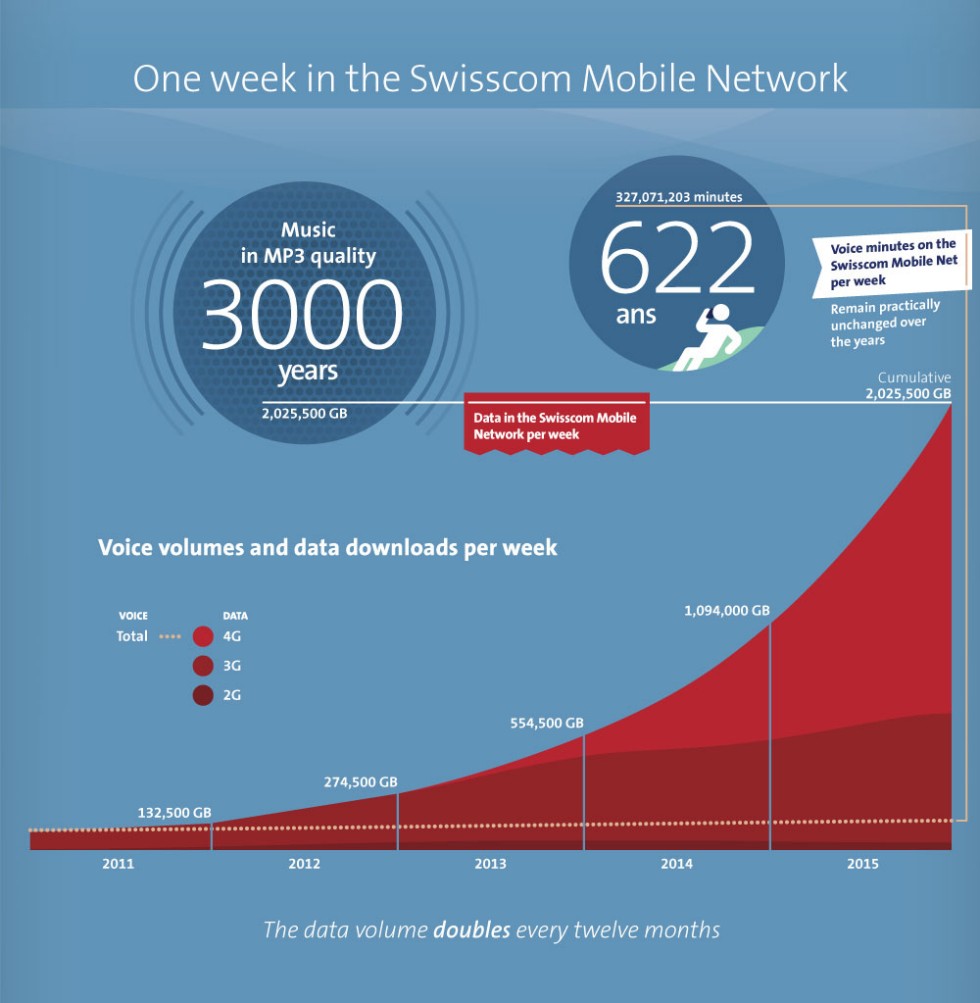Every year, the data volume that customers use over the Swisscom mobile network doubles. Three innovative approaches should also help manage this growth in future:
- Swisscom is increasing network capacity in urban areas with microcells developed in-house for cable conduits.
- The further development of LTE Advanced will once more offer customers higher speeds from 2016. The next mobile technology 5G is set to further increase speed and capacity significantly from 2020.
- 2G technology (GSM), which is now 22 years old, will no longer be supported from the end of 2020 in order to obtain sufficient frequencies and capacity for future customer needs with regard to telephony and data communication.

Every day, the Swisscom mobile network handles just under 290,000 gigabytes of data, which translates to more than 105 million gigabytes every year. This data volume doubles every twelve months. As networks become increasingly important for residential customers and businesses, their requirements are also becoming more demanding: “Our customers want to have access to the mobile broadband network any time, anywhere – and want to do so with excellent network quality and stability. So we can continue to offer them the best network in Switzerland in future, we now need to equip the network specifically for future requirements”, says Heinz Herren Head IT, Network and Innovation at Swisscom.
Innovative approach creates capacity: mobile communication antenna in the cable conduit
Particularly in urban areas, large numbers of customers access the wireless Internet simultaneously. To provide customers with the necessary bandwidth, Swisscom is adopting an innovative approach. It is based on mobile communication antennas and microcells developed in-house. These devices are installed into existing fixed network conduits in the road and use the power supply and Internet access available there. The antenna developed by Swisscom must be able to withstand demanding conditions, such as extreme weather or the weight of a 40-tonne lorry. Successful field trials were already conducted in the city of Berne in the first half of 2015. The next step will see the pilot extended to the cities of Basel, Lucerne and Zurich. The pilot is being conducted in collaboration with Ericsson and Kathrein. If the trial proves successful, wide-scale rollout will be feasible in 2016. Even when using antennas in this way, the relevant emission limit for non-ionizing radiation is met at all times.
Swisscom fine-tunes 4G and is set to launch 5G in 2020
Swisscom is further developing the existing 4G/LTE technology with LTE Advanced in order to provide greater capacity and speed. Swisscom has already rolled out LTE Advanced in 16 cities and is currently testing speeds of up to 450 Mbps as part of a pilot trial in the city of Fribourg. At the same time, Swisscom is the first provider anywhere in Europe to use a combination of the two LTE standards: FDD and TDD. Swisscom is set to augment its network with the next mobile technology 5G in 2020. 5G will again offer customers significantly increased speeds and greater capacity. The technology also boasts minimal response times and much lower energy consumption to run the network and for devices.
Laying the groundwork today for the network of the future
To free up sufficient frequencies for the further expansion of the 4G/LTE network and the rollout of 5G, Swisscom intends to phase out support for the 22-year-old 2G technology at the end of 2020. A mere 0.5 percent of mobile data traffic currently runs on the 2G network, even though the technology takes up 30% of antenna capacity. Telephony and SMS can already be routed via the powerful 3G and 4G/LTE networks, which even support HD voice quality. The switch-off in five years' time will affect residential customers with 2G-only devices as well as business customers with 2G solutions or 2G-based M2M applications. The Swisscom M2M platform will be fully 4G-capable from this autumn. Swisscom will be offering a compelling switch-over package to make it easier for the remaining around 2% of residential customers at the end of 2020 to switch to a new device. By announcing its plans early on, Swisscom aims to provide its customers with sufficient time to complete any switch-over.
Downloads
Contact us
Address
Swisscom
Media Relations
Alte Tiefenaustrasse 6
3048 Worblaufen
Postal address:
Postfach, CH-3050 Bern
Switzerland
Contact
Tel. +41 58 221 98 04
media@swisscom.com